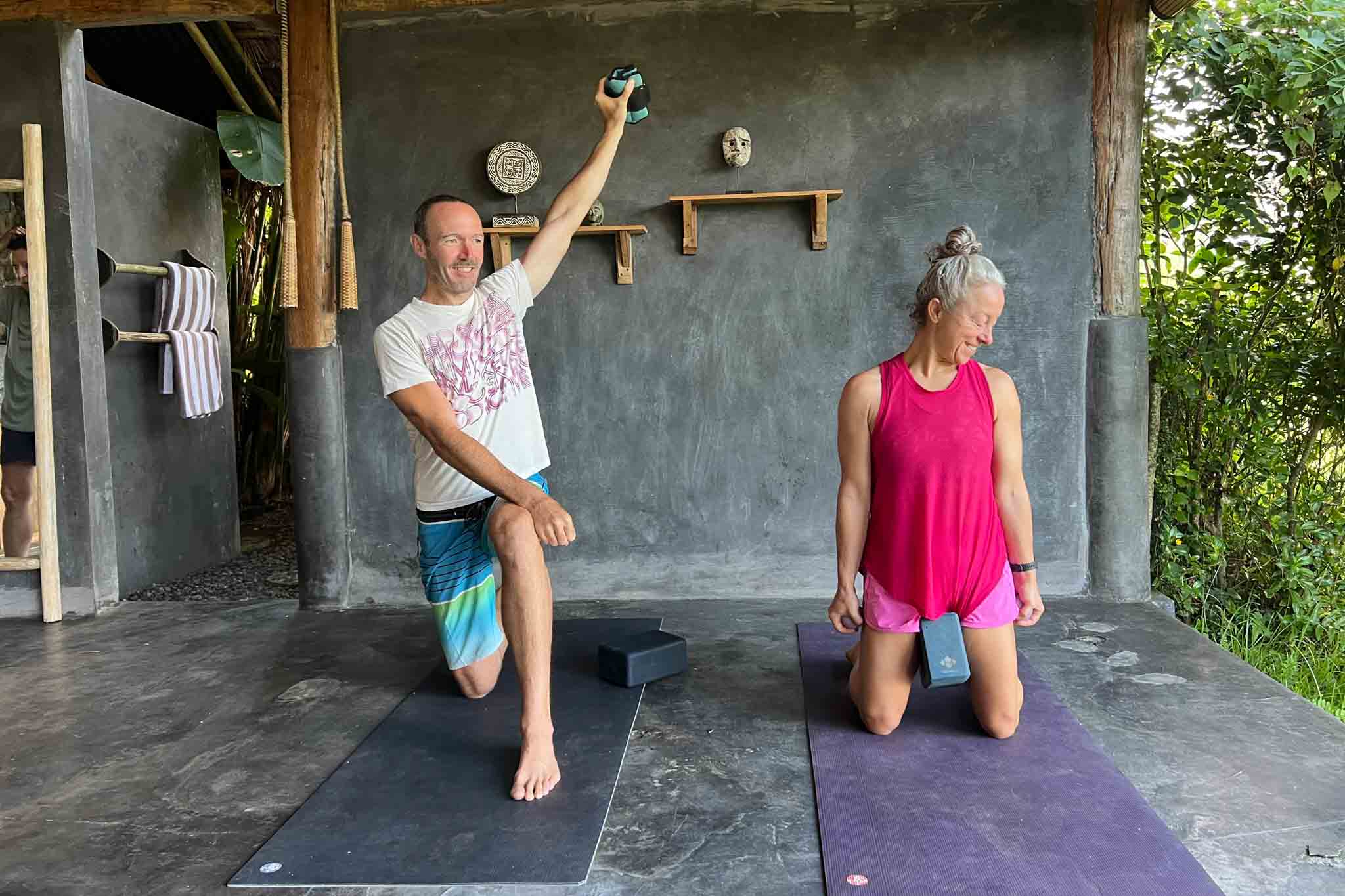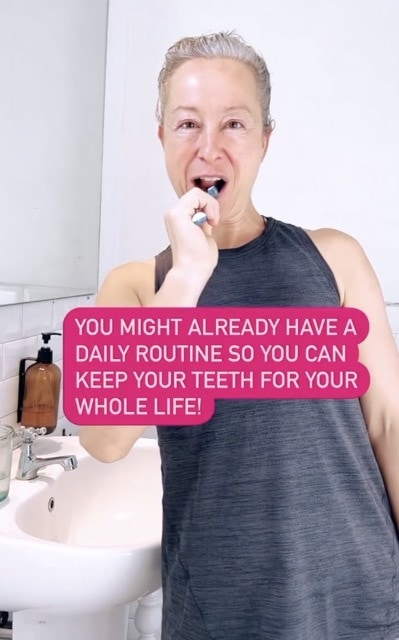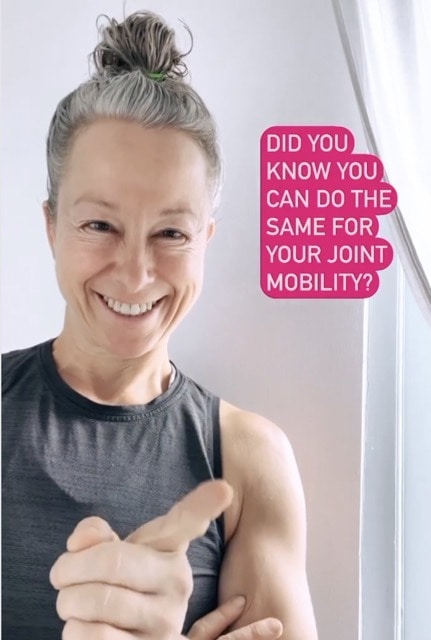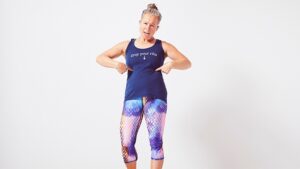UPDATED: April 18, 2025
It’s been over six years now since I discovered Controlled Articular Rotations (CARs) – a daily joint care & movement routine – and I’ve done CARs almost every day since then. That’s basically 2,190 days worth of CARs. And counting!!
Here’s the deal.
I discovered CARs at Christmas, 2018. In fact, they were my Christmas present to me and my partner Chris to support our surfing and traveling lifestyle back when it was brand new to us!
I bought a membership in an online mobility program, tried out the CARs, and we basically fell in love immediately. CARs are just that good! They feel great, they make your body feel awesome, and they’re super portable and do-able even when you’re busy. What’s not to love?!
Six years in and CARs are still our movement practice – every single morning to warm up for the day! The day just doesn’t feel right without them!
In fact, I think CARs are so good that I made us leave Mexico a month early so I could get certified to teach them. We went to Phoenix in March 2018 for the certification and boom! I’ve been a Functional Range Conditioning Mobility Specialist ever since and I’ve never looked back.
In this post I want to focus on what they are, why they’re so special & unique, and of course, I’ve got one of my favourite CARs for you to try.

What Are Controlled Articular Rotations aka CARs?
Basically, CARs are joint circles. But they’re mindful, careful joint circles done in a controlled, systematic way and with some technical tweaks. That means they help you get some really awesome benefits.
In this video Andreo Spina (the creator of the Functional Range Conditioning system – where CARS come from) explains why CARs are different from joint circles and the best way to use them.
Another important component of CARs is that they are an ACTIVE joint movement. That means you’re using your brain and muscles to make the largest possible rotation of the joint you’re working on. At the same time, you’re going to be working to keep everything else still.
A Note About Mobility & Flexibility
Did you know that flexibility is different from mobility? Definitions vary but here’s how I think about it.
‘Flexibility’ means a joint’s ability to passively stretch. How far can a joint bend if something outside your body (like the ground or a yoga strap) is pushing you? Someone with a lot of passive range – how far they can stretch a joint, no muscles required – can look very impressive! But flexibility without strength or control often isn’t super safe or helpful to longer term wellness goals.
‘Mobility’, on the other hand, is how far a joint can move all by itself. In other words, how much can your muscles move your joint around? This range can be very different from your passive range!! You need the passive range in order to have mobility, but you also need strength & muscular control.
While both flexibility and mobility have a place, it’s ACTIVE RANGE (mobility) that gives us control, smoothness and resilience in a joint. The smaller the gap between your active range and your passive range in any joint, the lower your risk of injury there.
CARs are a way to strengthen & practice your entire active range – which helps your joints work better and feel better over the long term!
Weekly movement inspiration you can’t wait to read!
Why Do Controlled Articular Rotations?
The movement problem that we need to solve – the biggest reason our bodies are breaking – is because we took hunter-gather adapted bodies and made them sit in chairs all day long.
Human bodies need movement. They just do. Large amounts of it, in a huge variety. More of it than most of us have time to manage, and more than we have ever had in our lives. Our bodies are movement starved, and so our physical capacity and our aches and pains reflect it. We have movement deficit disorder!!!
So, CARs to the rescue! CARs offer a lot of bang for your movement buck – they move every major joint of your body through its full range of motion – in a doable amount of time for super busy lives! This helps give your body the movement you need in all of your tiny parts. At the same time, it maintains your joint health & mobility.
And as you practice CARs, you’ll find that you get better and better at them. They aren’t an exercise you do only once, and they aren’t something you need to do perfectly to get the benefits. The practice itself delivers both immediate physical benefits and improves your movement skills over time.
There’s lots of ways to use CARs, but I think it’s best to start by doing them as a daily practice – the same way you might practice meditation. That’s how you’ll get the most benefits from them!
(If you’re ready to dive right in, check out my Joints for Life program here – I’ll teach you the whole body program, joint by joint, so you can learn progressively and build a sustainable CARs practice).
So What Are The Benefits Of CARs?
The best part is, CARs have some really cool benefits other than just giving your cells a chance to feel some movement (which is already a really big deal). Here are 10 of the reasons that I think CARs are the best single movement tool I’ve ever discovered.
#1 CARs reduce feelings of pain, aches & stiffness
Of course, every body is different – but I get emails every single day from my CARs students telling me how much they love the way CARs make them feel. If you’re ready to enjoy feeling more fluid and less stiff, CARs are one of the best ways to get there!
#2 CARs help connect your brain with your body
Your brain can only help you move well if it’s getting good information from your body. If your body is sending up bad info, your brain won’t know where you are in space. So the better you can connect your body with your brain, the more efficient, safe and effective your movement can be.
Fun fact: The nerves in our joints actually have an extra fast connection with our brains. This means that using our joints in a full range of motion gives our brains the best possible movement feedback. This helps us have a clear mental ‘body-map’ and lets our brains make better decisions about how to move us around the world.
Over time, improved brain-body connection will improve your balance, your fluidity and your ability to control your body as you move. In fact, it’s a key capacity that underlies all other movement! No matter what you love doing, having a good brain-body connection will help you do it better.
#3 CARs teach you about the state of your body
The more you do CARs, the more you’ll notice about how your body can move. You may learn that you struggle to move your hips. Or that you have a ‘sticky spot’ in your upper back. Or that one shoulder moves very differently than the other one.
Learning about your body with CARs will help you assess your current capabilities and help you set movement priorities. When you find something that doesn’t move well in your body, it’s always a good idea to work on improving it!
That’s because optimal movement is super efficient and health promoting. When a part of you isn’t moving well (for whatever reason) something else will compensate. That’s great because it means you can still do stuff! But over time, it’s not so great – compensation patterns are less efficient and can be damaging in the long run.
By practicing CARs, we can identify imbalances and areas that may not be moving well. At the same time, CARs themselves help all our parts move better. They’re not the whole story in decreasing compensation patterns but they’re an excellent first step!
#4 CARs are a mindfulness practice
You can do CARs pretty quickly, or you can do them really slowly. Either way, they require focus and concentration to do them well. I’m pretty sure this counts as meditation.
My partner and I have both really enjoyed the deep focus and exploration that comes from our CARs practice. It’s nice to take some time every day to focus on your body. Our culture tends to devalue pleasure, self-care and self love – and CARs are one option to take meaningful action on all three!
#5 CARs help you move better after you’re done
By taking your joints through their fullest range of movement, CARs use body stuff that often doesn’t get moved a lot. This lubricates your joints, warms up your muscles, feeds cells that might be hungry, and as I mentioned above, helps clarify your mental ‘body map’.
This means that after doing CARs your body will naturally be able to recruit more of its stuff once you get it out in the real world. This makes CARs an excellent warm up for any of your favourite activities – hiking, surfing, tennis, Zumba or gardening – whatever your day may bring! Your body will be able to bring more of its parts to the table once they’re warmed up and ready to go!
Then you get one of those great virtuous cycles – the more of your parts that you access in the real world, the more you actually improve your mobility, range of motion and capacity. We do CARs before every hike or MovNat workout, every time. Coffee + CARs every morning!
Banish that stiff, creaky, achy joint feeling in just 10-15 minutes a day!
#6 CARs improve the health and function of your joints
CARs move synovial fluid around – which is what feeds and cleans the cells in your joints. Cells love being well fed and cleaned up!! And CARs help reduce joint inflammation too. Plus they help you build high quality joint tissues when you practice over time. So you get healthier joint tissues and better joint function.
Better joint function means less pain and lower risk of injury – which means we’re more able to stay active. So you don’t just get healthier joints, you get healthier everything else, too!
#7 CARs move your entire body
Do you ever feel uncertain about how to focus your movement work? I know that whole body movement can be overwhelming – it often feels like you need to work on EVERYTHING.
Honestly, we probably do need to work on everything.
But if you start the day with CARs, you can know that you’ve moved an awful lot of your parts in really effective ways, right into your nooks and crannies.
So even if you haven’t done All The Things, doing CARs means you can feel confident that you’ve had some super helpful movement for every part of your body, every single day. Kind of like taking a movement multivitamin. Like vitamins, CARs aren’t the whole story – but they pack a very powerful punch!
#8 CARs help you maintain your current active range of motion
Bodies work on a use-it-or-lose it basis – that’s how they save energy. If you want to keep what you have, you need to keep using it. CARs will help you both find and keep whatever ya got.
(It’s especially important to maintain our ranges of motion as we get older. Our bodies really are use it or lose it – and when we lose range of motion, we start to lose capacity. In fact, age related changes can have some really negative impacts on our joints – our cartilage thins and rubs together and synovial fluid around the joints decreases – so it makes sense to choose movement tools that help us keep what we’ve got!)
Both Chris and I feel that CARs have improved our current range throughout our bodies and help us move more smoothly in our end ranges. We also feel like they’ve helped us work through some annoying nagging joint issues, which was a nice bonus.
Weekly movement inspiration you can’t wait to read!
#9 Your male partner might actually like CARs!!
For whatever reason, it seems like women are on the forefront of the movement revolution. I get emails all the time from women who are super into movement and living a movement based lifestyle but whose male partners are definitely not on board.
Well, from personal experience I can tell you that my boyfriend LOVES CARs. He might love them more than I do.
It’s super fun that we can do CARs together, and I’m also really happy that he’s taking good care of his parts by doing them daily. Chris says he likes them because CARs feel so good, take so little time and most of all, because he’s seen so many improvements in how his body feels & functions. Win, win, win.

Another fun fact: CARs were invented by two male chiropractors and are used, along with other FRS mobility work, by a fair number of professional sports teams (there’s a list on this page). If they’re good enough for the LA Lakers and the New York Yankees…
#10 Best of all, CARs are accessible!
You don’t have to be a professional athlete to use them, love them and benefit from them! They take a bit of time to learn, but once you get the hang of them, CARs only take 10-15 minutes a day (though you may love them so much that you do them for longer!)
Plus you can do them anywhere, any time. I’ve done them on boats, on mountains, on beaches, and in tiny Airbnbs where I can’t even roll out my yoga mat. You can do CARs without equipment, or you can use weights & bands to add resistance & give yourself more challenge.
Their accessibility, ‘feel-good’ nature and versatility means CARs actually GET DONE – which is the most important benefit of all!
Try CARs yourself – here’s one for your wrists!
You’ve heard me talk about CARs enough for now – why don’t you try one for yourself? A lot of us have really tight wrists – and although wrist CARS seem really simple, almost everyone struggles at first.
Give them a try and you’ll see what I mean!
What’d you think? Some of the CARs feel a bit juicier, but our wrists are really important when it comes to getting life done – so they’re worth working on!
Keep practicing wrist CARs until you can isolate your movement only at your wrists, no forearms, no fingers. Then keep on practicing! Your future self will thank you!
Like brushing your teeth…but for your joints
I’m willing to bet that you brush your teeth every day – so you can keep your teeth forever!


Well, CARs are a lot like brushing your teeth – but for your joints. I’ve never come across any other movement tools that are this powerful, versatile and doable – which is why I teach them with so much excitement! I designed my Joints For Life program to help you learn CARS – and to help you create a daily CARs practice you can stick to and benefit from for many years to come! You can click here to get all the details. Enjoy!!!







